
Mario & Luigi: Brothership is shaping up to be a real treat - hands-on preview
It’s anecdotal, but in my experience, the Mario & Luigi series has never quite garnered the mainstream recognition of Nintendo’s other plumber-centric RPG adventure brand, Paper Mario. At the very least, it’s long existed in the shadow of the recently-remade Super Mario RPG that started us down this split-path role-playing journey.
Perhaps it’s the series’ handheld-only nature that has held it back from turning more heads. If so, Mario & Luigi: Brothership should surely help; as the first entry to arrive on a home console - and the extremely successful Nintendo Switch, at that - Brothership is able to take full advantage of sterner tech to deliver more eye-catching visuals and a larger-scale world filled to the brim with quirky characters.
Having recently played Mario & Luigi: Brothership at a press preview event, I feel reasonably confident in saying that long-time fans will likely be pleased with Nintendo’s latest foray. The writing is as sharp as ever. Combat is a little faster, a little more action-centric, but it’s still turn-based goodness, through and through. It’s fun, it’s funny, and ultimately, that’s the one-two punch that I was looking for.

I sampled the game in two distinct sections, both of which begin with the titular brothers launching themselves from a cannon to reach their newfound island destination. The first of these two locations is Twistee Island, which I’m told is fairly early into the story.
The theme here is hinted at in its name - some of these folks love to groove. So much so, in fact, that their all-star dancer is called Groovemaster Dyode. His assistant, Emmit, is panicking because Dyode has lost his hair wax. Without it, Dyode just can’t get down with the funk. As you can see, it’s a high-stakes scenario with tragic consequences should Mario and Luigi fail to locate this lost MacGuffin.
Given how early this is, the battle system is fairly simple; it was on the second island, the festive Merrygo Island, that I got to dig more deeply. This is still relatively early, actually - I was told it’s “about 15%” of the way - but it’s evidently far enough to get a real feel for it.
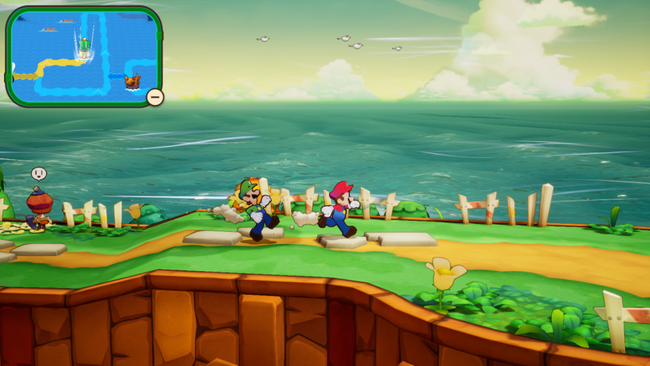
Bumping into an enemy on the overworld, or in my amateurish experience, more likely being bumped into, prompts combat. If your foe got the jump on you, they strike first. Every attack I dealt with in both slices of the demo can be dodged, or at least the damage can be mitigated, with well-timed reactions.
It may sound strange, but this is actually one of the things about Mario & Luigi: Brothership that’s impressed me the most. They’re all pretty different, so things stay fresh because you’ve got to learn all these attack patterns. They often require you to keep an eye on both brothers, too, since they’re often both at risk from multi-hit combos. It’s never especially demanding, but it’s hardly a cakewalk every time.
Turning the tables can involve just as much precision. Regular jump attacks require coordination between the brothers, as the one whose turn it is will leap first, but their steadfast companion will assist them in bouncing back into the fray to hit the enemy on the head all over again. At each point, pressing the button at the proper time ensures additional damage.
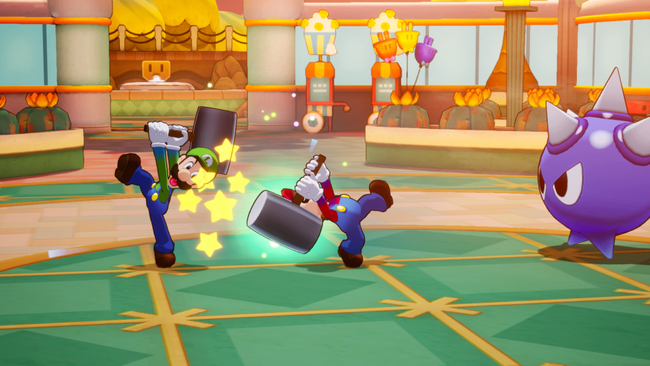
Attacks with your hammer are equally interesting. Let’s say it’s Mario’s turn. Mario swings at your selected foe, and you’re prompted to press the B button to line things up properly. A second or two later, and you press the A button to time it so that Luigi, who swings behind Mario, can launch his red-clad bro, hammer-to-hammer, into the same target for more.
Bros. Attacks, a staple in the Mario & Luigi series, return with much aplomb. Veterans will recognize some of these. Green Shell, for instance, involves the brothers rapidly kicking the shell at an enemy, then kicking it again once it ricochets off of them and back to your side of the battlefield. The shell can strike various targets, seemingly at random, making this a great crowd-control technique.
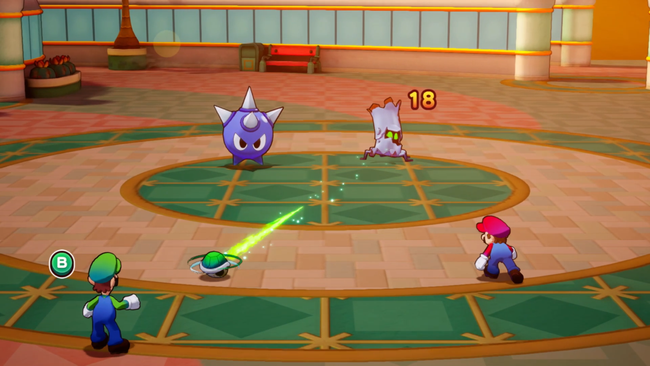
Of all the fight-related fare, though, it’s the Battle Plug mechanic that stood out to me the most. If you’re familiar with Badges from prior games, it’s essentially an evolution of those, but there’s a richer spread of choices than we’ve seen in the past. From what I could tell, I’d hazard a guess that there are dozens in all. You craft these with a specific currency, equipping a set number at a time.
Some are straightforward: a healing item is automatically used when a party member’s HP gets low, for example. Some, like Anti-Flying Specialist, are designed for deployment against specific types of enemies. Others, however, can really change the flow of battle. With Surprise Iron Ball, getting an “Excellent” rating with a Jump or Hammer Attack causes an iron ball to drop on the target for more damage. Surefooted Guard prevents the Trip and Dizzy status effects. Empower Counters turns jump counters into ground pounds, and charges up hammer counters by 30%.
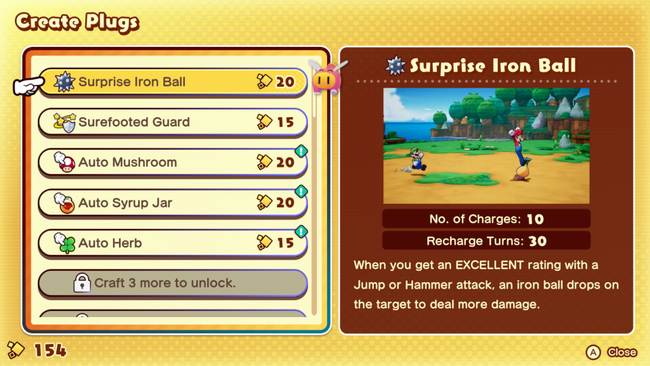
And then there are Plug Combos like Ka-Specialist, which causes critical-hit damage to spread to the rest of the enemy team when you use the Kaboom Attack technique with a Specialist-type Battle Plug equipped. These add a measure of depth to your decisions that’s in-line with other considerations throughout Mario & Luigi: Brothership, such as what to equip, which rank-up bonuses to select when leveling up (including, as it happens, a bonus allowing you to equip more gear at any given time), even whose shop to unlock first between the characters Maykit and Billdit, whose names suit their functions to a tee.
Exploration and puzzle-solving frequently tap into the camaraderie between Mario and Luigi that has always propped up this series in charming ways. Various interactive tidbits on the islands can cause Luigi to ponder up an odd idea with generally positive results. The story uses this as well; on Merrygo Island, I needed to navigate a big rotating maze, finding openings in each layer to allow further progress.
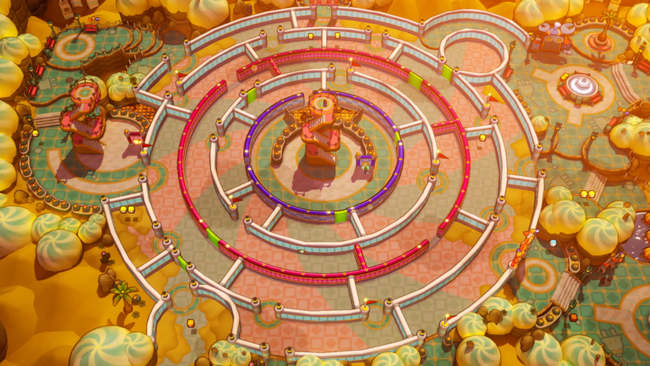
Climbing a tower at the center of the maze gave me an overhead view, but in order to turn it about as necessary, I’d need to tell Luigi - still down on ground level - to swing his hammer at a switch while Mario did the same atop the tower. It’s little things like this that can have a surprisingly big impact on Mario & Luigi’s moment-to-moment enjoyment. There’s a separate button to press for each brother’s hammer swing, so a very simple mechanic nevertheless successfully highlights the “teamwork makes the dream work” idea at the heart of the Mario & Luigi series.
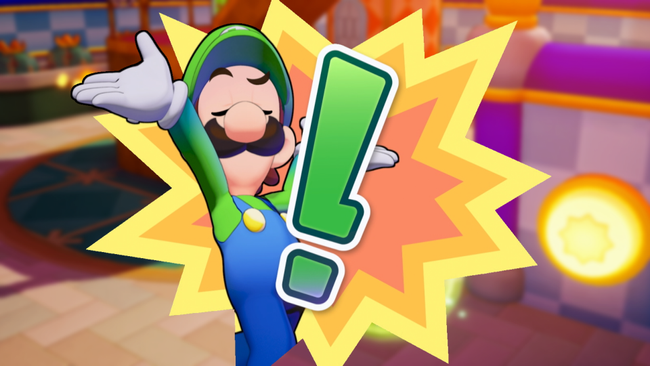
Ultimately, Mario & Luigi: Brothership is a game about connections, be they between siblings and their tools or a vast sea and its many islands. Completing an island links it up to the heroes’ boat, which is not just a big overarching goal for the game, but it has the bonus of linking up NPCs so that their services can be offered at your hub on a regular basis.
I don’t think anyone playing a Mario-branded RPG is looking for some epic narrative, but rather, something smaller, cozier, and endearing. Yet the series has often thrived on taking that approach and expanding it in creative ways; the shining example being Bowser’s Inside Story, which can’t get much smaller, as much of the game is set inside the villain’s body, but it’s full to bursting with memorable moments.
Mario & Luigi: Brothership’s scope is certainly wider, and its console-bound presentation is a beauty to behold. The RPG mechanics are bigger and bolder than ever. But in all the right ways, it’s still got that smallness and coziness that keeps me coming back. I was thrilled when Groovemaster Dyode got his hair wax back, and I look forward to helping more eccentric individuals when the game launches on November 7th.